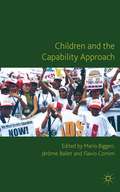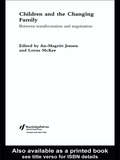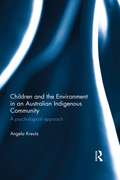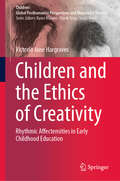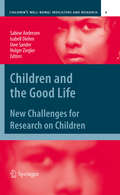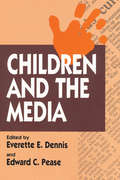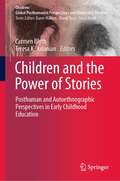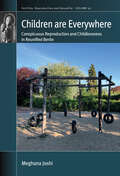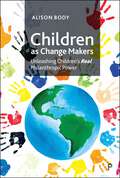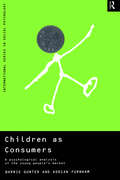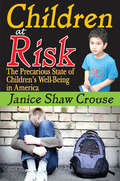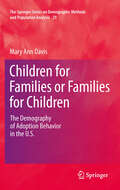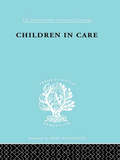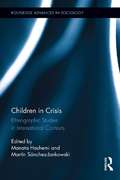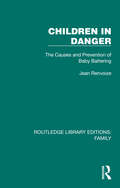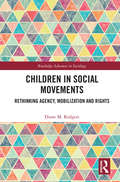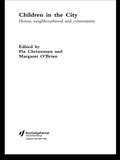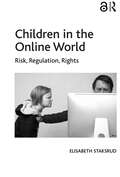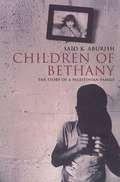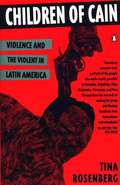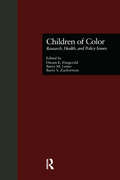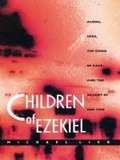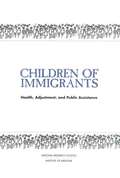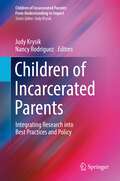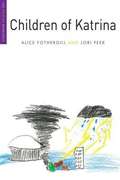- Table View
- List View
Children and the Capability Approach
by Flavio Comim Mario Biggeri J�r�me BalletExploring a wide variety of case studies and developmental issues from a capability perspective, this book is an original contribution to both development and children's studies that raises a strong case for placing children's issues at the core of human development.
Children and the Changing Family: Between Transformation and Negotiation
by An-Magritt JensenThis timely and thought-provoking book explores how social and family change are colouring the experience of childhood. The book is centred around three major changes: parental employment, family composition and ideology. The authors demonstrate how children's families are transformed in accordance with societal changes in demographic and economic terms, and as a result of the choices parents make in response to these changes. Despite claims that society is becoming increasingly child-centred, this book argues that children still have little influence over the major changes in their lives.This book breaks new ground by researching family change from the child's point of view. Through combinations from childhood experts in Scandinavia, the UK and America, the book shows the importance of studying children's lives in families in order to understand how far children are active agents in contemporary society.Students of childhood studies, sociology, social work and education will find this book essential reading. It will also be of interest to practitioners in the social, child and youth services.
Children and the Environment in an Australian Indigenous Community: A psychological approach
by Angela KreutzAboriginal children represent one of the fastest growing population segments in Australia, yet the lives of Aboriginal children in their environment has rarely been subjected to systematic and in-depth study. In this book, Angela Kreutz considers the relationship between the environment, attachment and development in indigenous children, examining theoretical constructs and conceptual models by empirically road testing these ideas within a distinct cultural community. The book presents the first empirical study on Australian Aboriginal children’s lives from within the field of child-environment studies, employing an environmental psychology perspective, combined with architectural and anthropological understandings. Chapters offer valuable insights into participatory planning and design solutions concerning Aboriginal children in their distinct community environment, and the cross-cultural character of the case study illuminates the commonalities of child development, as well as recognising the uniqueness that stems from specific histories in specific places. Children and the Environment in an Australian Indigenous Community makes significant theoretical, methodological and practical contributions to the international cross disciplinary field of child-environment studies. It will be of key interest to researchers from the fields of environmental, ecological, developmental and social psychology, as well as anthropologists, sociologists, and those studying the environment and planning.
Children and the Ethics of Creativity: Rhythmic Affectensities in Early Childhood Education (Children: Global Posthumanist Perspectives and Materialist Theories)
by Victoria Jane HargravesThis book presents a critical reimagining of education and educational research in addressing practices of representation and their relation to epistemology, subjectivity and ontology in the context of early childhood education. Drawing on posthumanist perspectives and the immanent materialism of Deleuze & Guattari to conceive of early childhood education, childhood and indeed, adult life, in new ways, it highlights the powerful role of language in subjectivity and ontology, and introduces affectensity as a concept which can be put to work to undo habitual relations and meanings. It proposes that ethical becomings require the engagement of an expansion and intensification of a body’s affect or capacity, and offers readers a provocation for enhancing creative capacity as an ethic. This book is an important contribution to the discussions on methods for living and of ways of thinking commensurate with the orientation of a posthuman turn.
Children and the Good Life: New Challenges for Research on Children (Children’s Well-Being: Indicators and Research #4)
by Uwe Sander Sabine Andresen Isabell Diehm Holger ZieglerIn April 2009, an inspiring international conference was held at Bielefeld on the topic "Children and the Good Life: New Challenges for Research on Children." The focus was on how we can define and measure a "good life" for children growing up in the modern world. This tied in with discussions on how convincing universalistic theories are, what research on children can contribute, and how children themselves can be integrated into the research process and debates on the "good life." Discourses and the production of knowledge on the "good life" or "well-being" require a guiding idea or a theoretical frame. This frame can come from the feminist ethic of care or from the Human and Children's Rights Convention, from the idea of welfare, or from the Capability Approach.
Children and the Media
by Everette E. DennisThroughout history the media has primarily been produced by adults, for adults, about adults. Increasingly, children have become a matter of high priority in the modern media society, and as they have, they have also become the subject of much concern. From debates in Congress about the detrimental effects of movies, comic books, and video games over the last century to efforts to court children as media consumers, there is a clear recognition that the media are not now and probably never were purely adult fare. Their impact on children is at issue.
Children and the Power of Stories: Posthuman and Autoethnographic Perspectives in Early Childhood Education (Children: Global Posthumanist Perspectives and Materialist Theories)
by Carmen Blyth Teresa K. AslanianThis book explores how stretching stories through posthuman and autoethnographic perspectives can produce new stories that decolon(ial)ize traditional thinking and approaches to Early Childhood Education (ECE). It demonstrates how stories can provide a different way of knowing, and a way of knowing differently: a way of decolon(ial)izing current discourses of early childhood education within educational institutions.The book uses research and practice in ECE to act as a canvas, a context with which to explore how autoethnography can become other when viewed through a posthumanist lens. As a consequence the chapters and stories within allow for an interplay between the posthumanist and the autoethnographic, an interplay that allows for a very specific type of meaning to emerge; a meaning that traffics in numerous and disruptive possibilities rather than settled certainties. In so doing, authors rethink and perturb the notion of child-centered approaches to knowing, be(com)ing, and doing within the Early Childhood Education context.
Children are Everywhere: Conspicuous Reproduction and Childlessness in Reunified Berlin (Fertility, Reproduction and Sexuality: Social and Cultural Perspectives #53)
by Meghana JoshiChildren are Everywhere engages with how demographic anxieties and reproductive regimes emerge as forms of social inclusion and exclusion in a low fertility Western European context. This book explores everyday experiences of parenting and childlessness of ‘ethnic’ Germans in Berlin, who came of age around the fall of the Berlin Wall, and brings them into conversation with theories on parenting, waithood, non-biological intimacies, and masculinities. This is the first ethnographic work by a South Asian author on demographic anxieties and reproduction in Germany and reverses the anthropological gaze to study Europe as the ‘Other.’
Children as Change Makers: Unleashing Children’s Real Philanthropic Power
by Alison BodyHow can we help children make a difference, allowing them to shape their communities, locally and globally? Drawing on a rich blend of academic research and case studies, Alison Body critically examines societal structures, including education, communities and cultural narratives, that shape children's understanding of active, philanthropic citizenship. Children as Change-Makers calls for a reimagining of philanthropy as a form of participatory citizenship, advocating for a philanthropic ecosystem framed by justice, solidarity and collective action. It serves as a roadmap for all stakeholders – from individuals to institutions – to empower children as agents of positive social change, fostering a more just world for generations to come.
Children as Consumers: A Psychological Analysis of the Young People's Market (International Series in Social Psychology)
by Adrian Furnham Barrie GunterThe children's and teenagers' market has become increasingly significant as young people have become more affluent and have an ever growing disposable income. Children as Consumers traces the stages of consumer development through which children pass and examines the key sources of influence upon young people's consumer socialisation. It examines: * the kinds of things young people consume * how they use their money * how they respond to different types of advertising * whether they need to be protected through special legislation and regulation * market research techniques that work well with young people. Children as Consumers will be useful to students of psychology, sociology, business and media studies, as well as professionals in advertising and marketing.
Children at Risk: The Precarious State of Children's Well-being in America
by Janice Shaw CrouseThe desire for our children to be free from want and danger and to be able to enjoy their youth in innocence would seem to be universal. Conventional wisdom says that parents in every socio-economic level of society share the dream of preserving their children's innocence. All want to provide a childhood and adolescence that shelters and protects children from the harshness of life and nurtures them until they are able to withstand the onslaught of reality. One need only look at troubled areas of the world, such as Northern Ireland, parts of the Middle East, or any number of other points on the globe, to see how weak is any communion forged out of these universal desires for the welfare of children. Even in the United States, the competition of ideas and values about what represents the "good" society in which to raise our children is fierce-as are differing views about the value of innocence and even life itself. These differing ideas and values affect people's actions even when they have never reflected on them, or have never cared enough to formulate those values into a coherent worldview. Crouse contends that without morals, children are at risk. Moral boundaries, not moral relativism, provide a safe haven for children by preserving their innocence and protecting them from predators and pedophiles. When authentic religious faith has been quashed, children are no longer safe. When the underlying values are wrong, when there are no common values unifying a people, even the best programs and most honorable of intentions are doomed to failure. Well-intentioned programs and policies inevitably fail miserably without an undergirding moral foundation, as is documented by an abundance of data and the social trends in America today.
Children for Families or Families for Children: The Demography of Adoption Behavior in the U.S. (The Springer Series on Demographic Methods and Population Analysis #29)
by Mary Ann DavisDo adoptions provide children for families or families for children? This book analyzes the complex interactions between adopters and adoptees using historical and current data. Who are the preferred parents and children, both domestically and internationally? How do the types of adoptions-domestic adoptions, private and public through the foster care system, and intercountry adoptions-differ? Domestic trends include a shift to open adoptions and a notable increase in "hard to place", foster care adoptions-typically older, siblings, minorities, with physical, educational, or emotional challenges. Adoptive parents are increasingly all ages (including grandparents); all types of marriages (single, married and same-sex couples); all income levels, with subsidized adoptions for children who would otherwise remain in foster or institutional care. Intercountry adoptions have followed waves, pushed by wars and political or economic crises in the sending country, and pulled by the increasing demand from the U. S. Currently there is a decrease in intercountry adoptions from Asia and Eastern Europe with a possible fifth wave from Africa with the greatest number from Ethiopia. This is a resource for family sociologists, demographers, social workers, advocates for children and adoptive parents, as well as those who are interested in the continuing research in adoptions.
Children in Care: The Development of the Service for the Deprived Child (International Library of Sociology #Vol. 142)
by Jean S. HeywoodFirst published in 1998. Routledge is an imprint of Taylor & Francis, an informa company.
Children in Crisis: Ethnographic Studies in International Contexts (Routledge Advances in Sociology #105)
by Martín Sánchez-Jankowski Manata HashemiThis volume brings together ethnographers conducting research on children living in crisis situations in both developing and developed regions, taking a cross-cultural approach that spans different cities in the global North and South to provide insight and analyses into the lifeworlds of their young, at-risk inhabitants. Looking at the lived experiences of poverty, drastic inequality, displacement, ecological degradation and war in countries including Haiti, Argentina and Palestine, the book shows how children both respond to and are shaped by their circumstances. Going beyond conventional images of children subjected to starvation, hunger, and disease to build an integrated analysis of what it means to be a child in crisis in the 21st century, the book makes a significant contribution to the nascent field of study concerned with development and childhood. With children now at the forefront of debates on human rights and poverty reduction, there is no better time for scholars, policymakers and the general public to understand the complex social, economic and political dynamics that characterize their present predicaments and future life chances.
Children in Danger: The Causes and Prevention of Baby Battering (Routledge Library Editions: Family)
by Jean RenvoizeIn the early 1970s ‘baby battering’ accounted for an estimated 700 child deaths a year in Britain, while a further 4-5,000 children were seriously injured – all this in spite of the knowledge gained from the research done both in Britain and in the United States. How could such tragedies be prevented? What is known about the parents, the family patterns and social situations that gave rise to baby battering? Extraordinary public interest had been aroused by the appalling case of Maria Colwell, and the problem of baby battering was now receiving the close attention it had long warranted. Originally published in 1974, Jean Renvoize had spent two years interviewing the battering parents themselves, as well as social workers, doctors, the police and psychiatrists. The special virtue of Children in Danger was that, apart from being the first fully-researched book on the subject, the author was able to look at baby battering as an outsider, seeing the picture as a whole. Her overwhelming impression is that although lip-service was paid to the idea of cooperation between all professionals working in the field, the truth was that too frequently a deep distrust existed between them, particularly between social workers and the police. The result of this distrust was that every year thousands of children fell through the social welfare net with tragic results. Jean Renvoize discusses frankly and impartially the ways the various professions regard each other, and she makes constructive suggestions for the future. The taped stories of several battering parents, which illustrate how narrow the line is between necessary discipline and near-cruelty, between extreme exasperation and uncontrolled attack, are a moving and illuminating feature of the book. These parents talk not only about their lives and the events which led them towards actions they will never cease regretting, but also about their views of the help that was given them, or the lack of it. They are articulate and self-aware, and here for the first time their story is heard, along with the various professional explanations of why some people cannot stop themselves attacking the children whom they long to love.
Children in Social Movements: Rethinking Agency, Mobilization and Rights (Routledge Advances in Sociology)
by Diane M. RodgersChildren’s participation in social movements is presented through a theoretical typology consisting of strategic participants, participants by default and active participants. This range of participation accounts for the social location of children historically and internationally, calling for their inclusion into social movement research. Children are unresearched and untheorized participants within social movement literature. Providing rich detail of children’s participation through illustrative case studies, this book presents the ideal types of participation as grounded in their social movement activity. These cross cultural, historical and contemporary case studies include, whenever possible, children’s perspective in their own words. Utilizing insights from childhood studies on agency and rights of children enhances the understanding of social movement strategies and mobilization. Following the chapters on each type of participation, suggestions are provided for rethinking existing social movement theories to acknowledge child participants. Scholars and students of social movements and childhood studies, as well as within the field of sociology will find interest in the wide range of case studies presented of children in social movements. The discussion of how social movement theory might be applied to the types of participation is meant to inspire future research and expand analysis of children’s participation in social movements.
Children in the City: Home Neighbourhood and Community
by Pia Christensen Margaret O’BrienThis timely and thought-provoking book explores children's lives in modern cities. At a time of intense debate about the quality of life in cities, this book examines how they can become good places for children to live in. Through contributions from childhood experts in Europe, Australia and America, the book shows the importance of studying children's lives in cities in a comparative and generational perspective. It also contains fascinating accounts of city living from children themselves, and offers practical design solutions.The authors consider the importance of the city as a social, material and cultural place for children, and explore the connections and boundaries between home, neighbourhood, community and city. Throughout, they stress the importance of engaging with how children see their city in order to reform it within a child-sensitive framework.This book is invaluable reading for students and academics in the field of anthropology, sociology, social policy and education. It will also be of interest to those working in the field of architecture, urban planning and design.
Children in the Online World: Risk, Regulation, Rights
by Elisabeth StaksrudWhat is online risk? How can we best protect children from it? Who should be responsible for this protection? Is all protection good? Can Internet users trust the industry? These and other fundamental questions are discussed in this book. Beginning with the premise that the political and democratic processes in a society are affected by the way in which that society defines and perceives risks, Children in the Online World offers insights into the contemporary regulation of online risk for children (including teens), examining the questions of whether such regulation is legitimate and whether it does in fact result in the sacrifice of certain fundamental human rights. The book draws on representative studies with European children concerning their actual online risk experiences as well as an extensive review of regulatory rationales in the European Union, to contend that the institutions of the western European welfare states charged with protecting children have changed fundamentally, at the cost of the level of security that they provide. In consequence, children at once have more rights with regard to their personal decision making as digital consumers, yet fewer democratic rights to participation and protection as ’digital citizens’. A theoretically informed, yet empirically grounded study of the relationship between core democratic values and the duty to protect young people in the media-sphere, Children in the Online World will appeal to scholars and students across the social sciences with interests in new technologies, risk and the sociology of childhood and youth.
Children of Bethany: The Story of a Palestinian Family
by Saïd K. AburishAburish unflinchingly writes of his family, telling of village life after WWI, the disruption after WWII, and the Palestinian diaspora which began then. His work gives an understanding of a culture, a family through time, and a tragedy of 20th century dislocation.
Children of Cain
by Tina RosenbergAn honest judge in Medellin, a Maoist guerilla of Peru's Shining Path, the fair-haired Angel of Death in Argentina's Dirty War, the pool-party rich of El Salvador, the disabused revolutionaries of Nicaragua, and the ordinary Chileans who became silent partners in Pinochet's dictatorship-these people live in Latin America, but their stories illuminate the human face of violence all over the world. Tina Rosenberg spent five years trying to understand their world and learning to live with these "children of Cain." Their stories are disturbing precisely because these people are not monsters; the faces in Children of Cain are not those of strangers.
Children of Color: Research, Health, and Policy Issues
by Barry M. Lester Hiram E. FitzgeraldBy the year 2050, the population of the United States is projected to be approximately half white and half non-white. Yet the knowledge of child development within ethnic minority groups lags markedly behind knowledge of child development for white Americans, and it is increasingly clear that the rich diversity within minority groups is masked by studies focusing on between-group comparisons. Children of Color: Research, Health, and Public Policy Issues , a collection of original essays, brings together researchers from the fields of education, family and child ecology, nursing, psychology, sociology, pediatrics, anthropology, and social work to explore the rich cultural, familial, and individual diversity of all ethnic minority groups. The essays were generated by round table discussions sponsored by the Society for Research in Child Development and the Irving Harris Foundation, and they cover a broad range of topics including immigration policy, social policy, health status of immigrant infants, children and families, and educational policies related to minority children.
Children of Ezekiel: Aliens, UFOs, the Crisis of Race, and the Advent of End Time
by Michael LiebAre Milton's Paradise Lost, Ronald Reagan's "Star Wars" missile defense program, our culture's fascination with UFOs and alien abductions, and Louis Farrakhan's views on racial Armageddon somehow linked? In Children of Ezekiel Michael Lieb reveals the connections between these phenomena and the way culture has persistently related the divine to the technological. In a work of special interest at the approach of the millennium, Lieb traces these and other diverse cultural moments--all descended from the prophet Ezekiel's vision of a fiery divine chariot in the sky--from antiquity to the present, across high and low culture, to reveal the pervasive impact of this visionary experience on the modern world. Beginning with the merkabah chariot literature of Hebrew and Gnostic mysticism, Lieb shows how religiously inspired people concerned with annihilating their heretical enemies seized on Ezekiel's vision as revealing the technologically superior instrument of God's righteous anger. He describes how many who seek to know the unknowable that is the power of God conceive it in technological terms--and how that power is associated with political aims and a heralding of the end of time. For Milton, Ezekiel's chariot becomes the vehicle in which the Son of God does battle with the rebellious angels. In the modern age, it may take the form of a locomotive, tank, airplane, missile, or UFO. Technology itself is seen as a divine gift and an embodiment of God in the temporal world. As Lieb demonstrates, the impetus to produce modern technology arises not merely from the desire for profit or military might but also from religious-spiritual motives. Including discussions of conservative evangelical Christian movements, Reagan's ballistic shooting gallery in the sky, and the Nation of Islam's vision of the "mother plane" as the vehicle of retribution in the war against racial oppression, Children of Ezekiel will enthrall readers who have been captivated, either through religious belief or intellectual interests, by a common thread uniting millennial religious beliefs, racial conflict, and political and militaristic aspirations.
Children of Immigrants: Health, Adjustment, and Public Assistance
by Institute of Medicine National Research CouncilImmigrant children and youth are the fastest-growing segment of the U.S. population, and so their prospects bear heavily on the well-being of the country. Children of Immigrants represents some of the very best and most extensive research efforts to date on the circumstances, health, and development of children in immigrant families and the delivery of health and social services to these children and their families.This book presents new, detailed analyses of more than a dozen existing datasets that constitute a large share of the national system for monitoring the health and well-being of the U.S. population. Prior to these new analyses, few of these datasets had been used to assess the circumstances of children in immigrant families. The analyses enormously expand the available knowledge about the physical and mental health status and risk behaviors, educational experiences and outcomes, and socioeconomic and demographic circumstances of first- and second-generation immigrant children, compared with children with U.S.-born parents.
Children of Incarcerated Parents: Integrating Research into Best Practices and Policy (Children of Incarcerated Parents: From Understanding to Impact)
by Nancy Rodriguez Judy KrysikThis book presents multidimensional knowledge on children of incarcerated parents using Bronfenbrenner’s ecological theory as an organizing framework. It examines the extent to which different levels of the environment are supportive (i.e., leading to resilience) and stress-producing (i.e., contributing to risk). The volume explores four levels of the environment – microsystem, mesosystem, exosystem, and macrosystem – with specific theories and paradigms woven into the inquiry at each. At the level of child and family, it discusses the factors that influence resilience and risk in children from gestation through young adulthood; at the community level, it addresses risk and resilience in the interactions between children and families and the various systems with which they interact (e.g., child welfare). Key areas of coverage include: · A description of the factors that influence the quality of programming for children and their families. · A critical analysis of state and national policies that affect which individuals receive, or fail to receive, specific services. · An overview and evaluation of the state of knowledge and implications for research and practice to improve outcomes for children of incarcerated parents. · An organizing framework to help researchers identify gaps in the existing knowledge base and distills and organizes evidence-based information for practitioners. Children of Incarcerated Parents is an essential resource for researchers, professors, and graduate students as well as practitioners, therapists, and other professionals in child and school psychology, family studies, public health, and all interrelated disciplines, including developmental psychology, criminal justice, social work, educational policy and politics.
Children of Katrina
by Lori Peek Alice FothergillWhen children experience upheaval and trauma, adults often view them as either vulnerable and helpless or as resilient and able to easily "bounce back. " But the reality is far more complex for the children and youth whose lives are suddenly upended by disaster. How are children actually affected by catastrophic events and how do they cope with the damage and disruption?Children of Katrina offers one of the only long-term, multiyear studies of young people following disaster. Sociologists Alice Fothergill and Lori Peek spent seven years after Hurricane Katrina interviewing and observing several hundred children and their family members, friends, neighbors, teachers, and other caregivers. In this book, they focus intimately on seven children between the ages of three and eighteen, selected because they exemplify the varied experiences of the larger group. They find that children followed three different post-disaster trajectories-declining, finding equilibrium, and fluctuating-as they tried to regain stability. The children's moving stories illuminate how a devastating disaster affects individual health and well-being, family situations, housing and neighborhood contexts, schooling, peer relationships, and extracurricular activities. This work also demonstrates how outcomes were often worse for children who were vulnerable and living in crisis before the storm. Fothergill and Peek clarify what kinds of assistance children need during emergency response and recovery periods, as well as the individual, familial, social, and structural factors that aid or hinder children in getting that support.
